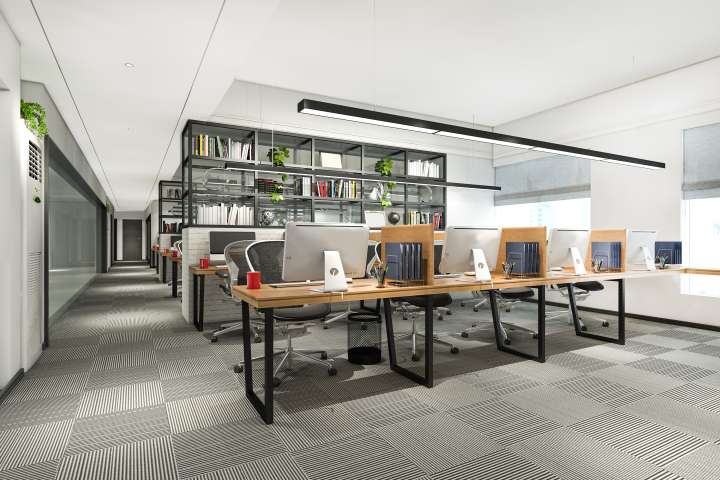In today’s fast-paced, technology-driven world, the demand for smarter, more efficient office spaces is on the rise. Modern office environments are evolving to incorporate advanced technologies that enhance productivity, comfort, and sustainability. Smart building solutions are at the forefront of this transformation, offering innovative ways to manage and optimize office operations. This article explores various smart building technologies and their benefits, providing insights into how these solutions are shaping the future of workspaces.

The Rise of Smart Buildings
Smart buildings integrate advanced technologies and systems to create more efficient, comfortable, and sustainable environments. These buildings utilize the Internet of Things (IoT), artificial intelligence (AI), and automation to monitor and control various aspects of the office space, from lighting and temperature to security and energy management. The goal is to create a seamless, connected environment that responds to the needs of its occupants in real-time.
Key Smart Building Solutions
-
Integrated Building Management Systems (BMS)
An Integrated Building Management System (BMS) is the backbone of a smart building. It centralizes the control of various building systems, including HVAC (heating, ventilation, and air conditioning), lighting, security, and energy management. By providing a unified interface, a BMS allows facility managers to monitor and optimize the building’s performance.
Benefits:
Energy Efficiency: A BMS can optimize energy use by adjusting lighting and HVAC settings based on occupancy and external conditions.
Enhanced Comfort: It maintains optimal indoor conditions, improving comfort for occupants.
Cost Savings: Reduced energy consumption translates to lower operational costs.
-
Smart Lighting Systems
Lighting is a significant energy consumer in office buildings. Smart lighting systems use sensors and controls to adjust lighting levels based on occupancy and natural light availability. These systems can be programmed to turn off lights in unoccupied areas and dim lights when sufficient daylight is present.
Benefits:
Energy Savings: Reducing unnecessary lighting can significantly cut energy usage.
Improved Productivity: Proper lighting enhances worker productivity and well-being.
Flexibility: Lighting can be customized to meet the specific needs of different areas and tasks.
-
Smart HVAC Systems
Heating, ventilation, and air conditioning are critical for maintaining a comfortable and healthy indoor environment. Smart HVAC systems use sensors and automation to regulate temperature and air quality. These systems can learn from occupancy patterns and weather forecasts to optimize performance.
Benefits:
Energy Efficiency: Smart HVAC systems reduce energy waste by adjusting settings based on real-time data.
Enhanced Comfort: They ensure consistent and comfortable indoor conditions.
Maintenance: Predictive maintenance features can alert facility managers to potential issues before they become serious problems.
-
Occupancy Sensors and Space Utilization
Occupancy sensors track the presence of people in different areas of the office. This data can be used to optimize space utilization, ensuring that resources are allocated efficiently. For instance, conference rooms and workstations can be managed based on actual usage patterns.
Benefits:
Optimized Space Use: Understanding how spaces are used can lead to more efficient layouts and better resource allocation.
Energy Savings: Sensors can control lighting and HVAC systems, reducing energy use in unoccupied areas.
Improved Planning: Data on space utilization helps in planning future office layouts and expansions.
-
IoT and Connectivity
The Internet of Things (IoT) connects various devices and systems within a building, allowing them to communicate and share data. This connectivity enables real-time monitoring and control, as well as data-driven decision-making.
Benefits:
Real-Time Monitoring: Facility managers can monitor building systems in real-time, making immediate adjustments as needed.
Data-Driven Insights: IoT devices generate vast amounts of data that can be analyzed to identify trends and areas for improvement.
Enhanced Security: Connected security systems provide real-time surveillance and alerts, improving overall safety.
Sustainable and Energy-Efficient Solutions
Sustainability is a key driver for smart building solutions. Modern office spaces are increasingly designed to minimize environmental impact and reduce energy consumption. This not only helps in achieving sustainability goals but also leads to significant cost savings.
Examples of Sustainable Solutions:
Solar Panels and Renewable Energy: Integrating renewable energy sources such as solar panels reduces reliance on non-renewable energy.
Energy Storage Systems: These systems store energy during low-demand periods and release it during peak demand, optimizing energy use.
Water Conservation Technologies: Smart irrigation and water use systems help in reducing water waste and managing consumption efficiently.
The Role of Electrical Infrastructure
A critical aspect of implementing smart building solutions is the underlying electrical infrastructure. Ensuring that the electrical systems are capable of supporting advanced technologies is essential for the effective functioning of smart building solutions. One of the key components in this infrastructure is the panel board, which distributes electrical power to different circuits within the building. A modern, well-maintained panel board is crucial for reliable operation and safety, ensuring that power is efficiently distributed and managed.
Case Study: Smart Building in Action
Consider a modern office building that has implemented a comprehensive suite of smart building solutions. The building uses an integrated BMS to control HVAC, lighting, and security systems. Occupancy sensors and IoT devices provide real-time data on space utilization and energy consumption.
By analyzing this data, the facility management team can optimize HVAC settings based on actual occupancy patterns, reducing energy waste. Smart lighting systems adjust automatically to natural light levels, enhancing comfort while cutting energy use. Additionally, predictive maintenance features alert the team to potential issues with HVAC and other systems, preventing costly breakdowns and downtime.
The building also integrates renewable energy sources, such as solar panels, and uses energy storage systems to manage energy use efficiently. As a result, the building achieves significant energy savings, reduced operational costs, and a smaller carbon footprint.
The Future of Smart Buildings
The future of smart buildings lies in the continued integration of advanced technologies and the development of new solutions that further enhance efficiency, comfort, and sustainability. Emerging trends include:
Artificial Intelligence (AI): AI will play a larger role in analyzing data, optimizing building performance, and providing predictive maintenance.
5G Connectivity: Faster and more reliable connectivity will enhance the performance of IoT devices and systems.
Advanced Energy Management: New energy management technologies will further reduce consumption and integrate renewable energy sources more effectively.
Conclusion
Smart building solutions are revolutionizing modern office spaces, providing significant benefits in terms of efficiency, comfort, and sustainability. By integrating advanced technologies such as BMS, smart lighting, HVAC systems, occupancy sensors, and IoT connectivity, office buildings can optimize operations, reduce energy consumption, and enhance the well-being of their occupants. As these technologies continue to evolve, the potential for creating even smarter, more efficient, and more sustainable office environments will only grow, paving the way for the future of workspaces.
We hope you found this blog post on Smart Building Solutions for Modern Office Spaces, useful. Be sure to check out our post on Office Design Ideas That Will Inspire Your Employees for more great tips!
Have Experience in the Moving Industry? Want an Additional Income Stream? Work With All Around Moving!
All Around Moving’s Work With Us program offers experienced moving consultants the chance to operate their own Relocation Consultant business from anywhere in the USA, providing licensing, dedicated phone lines, moving software, and profit sharing of 50-50 for all booked jobs. Click here to learn more.





